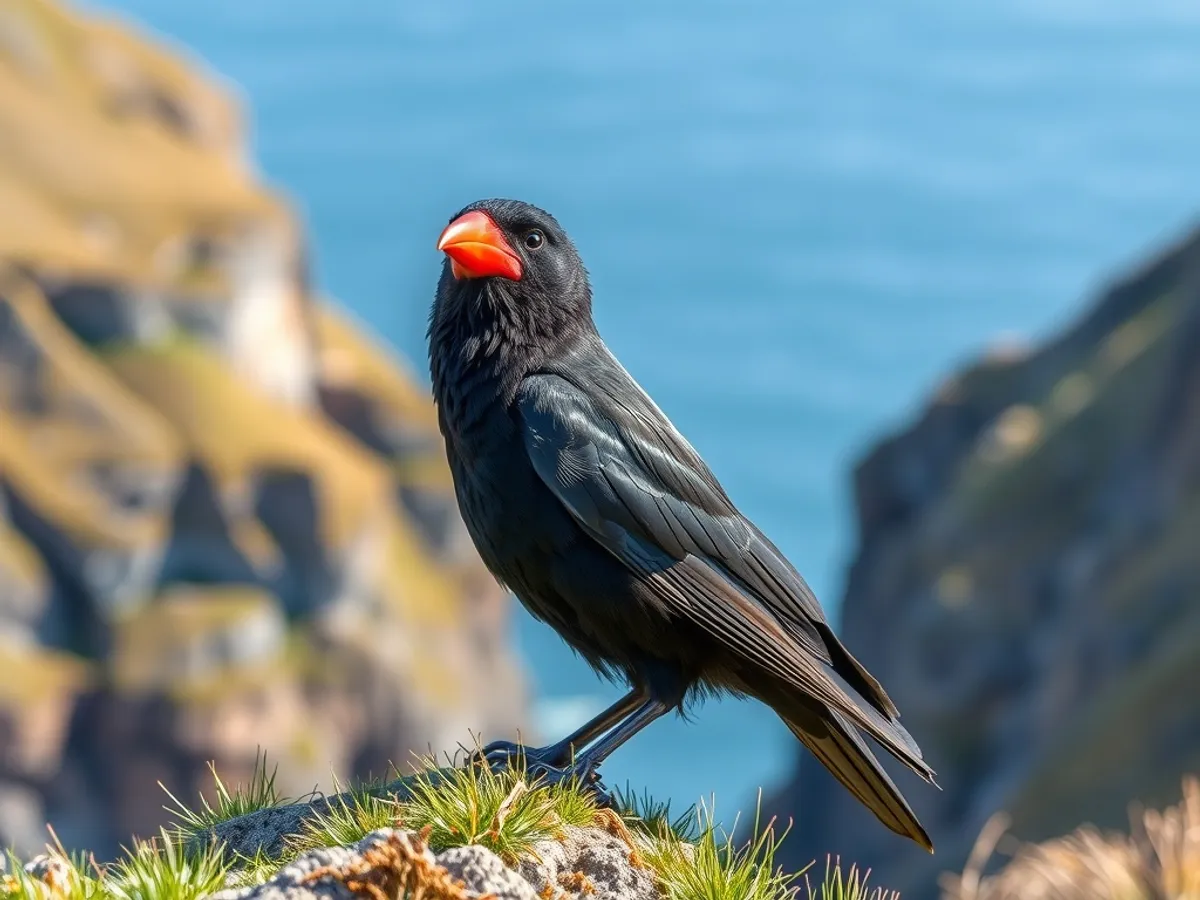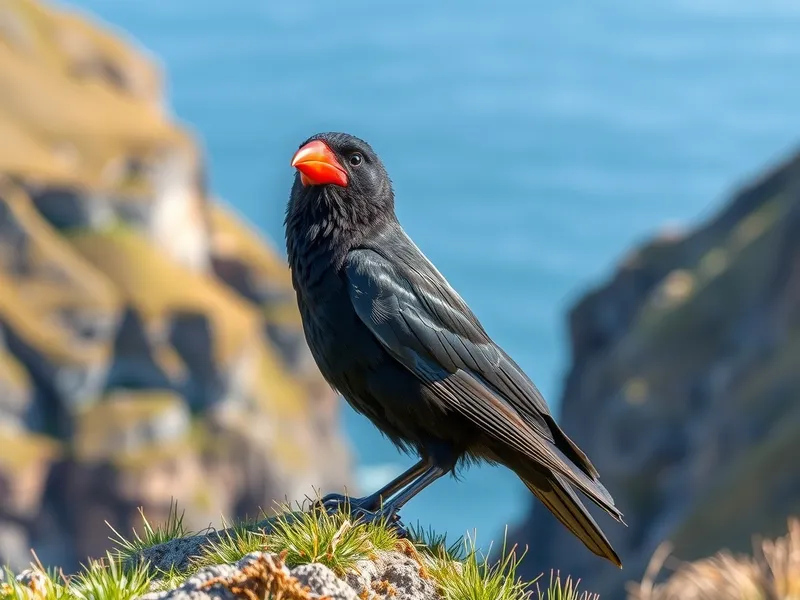
Red-billed Chough
Pyrrhocorax pyrrhocorax

Meet the Red-billed Chough
The Red-billed Chough is a striking medium-sized member of the crow family, easily recognized by its glossy black plumage and distinctive bright red, down-curved bill and legs. It is a highly agile flier, often performing acrobatic maneuvers over coastal cliffs and upland pastures. This bird is known for its loud, ringing calls and strong social bonds, often seen in small flocks. The Red-billed Chough has a patchy distribution across western Europe, North Africa, and parts of Asia, mainly inhabiting open, rocky areas and high-altitude grasslands.
Classification
Bird
Habitat
Coastal cliffs, mountain slopes, and upland grasslands
Diet
Omnivore
Lifespan
8-20 years
Conservation
Least Concern
Weight
230-350 grams
📖Fascinating Facts
Brilliant Bill
The Red-billed Chough’s bright red bill is specialized for probing into soil and dung to extract insects and larvae.
Coastal Dweller
They prefer windswept coastal cliffs and high mountain pastures, habitats where few other corvids venture.
Distinctive Calls
Their loud, ringing 'chee-ow' calls are often heard echoing across cliffs, giving rise to their onomatopoeic name.
📋Detailed Description
The Red-billed Chough (Pyrrhocorax pyrrhocorax) is a medium-sized corvid, measuring 39–40 cm in length with a wingspan of 73–90 cm and weighing between 230–370 grams. Its most distinctive features are its vivid, down-curved red bill and bright red legs, which contrast sharply with its glossy, iridescent black plumage. The wings are broad and fingered, and the tail is square, adaptations that contribute to its agile, acrobatic flight, often seen as aerial tumbling and swooping maneuvers along cliffs and steep slopes. The species has a strong, slightly decurved bill adapted for probing into soil and dung for invertebrates. Its vocalizations are loud, clear, and metallic, with a characteristic 'chee-ow' call. Socially, Red-billed Choughs are highly gregarious outside the breeding season, forming flocks that can number from a few individuals to over a hundred. They exhibit complex social hierarchies and cooperative behaviors, especially in foraging and predator vigilance. Breeding pairs are monogamous and maintain long-term bonds, often returning to the same nesting sites year after year. The species is long-lived, with individuals in the wild known to reach 17 years or more. Their habitat preference for open, short-sward grasslands and rocky outcrops is closely linked to their foraging strategy and nesting requirements.
💡 Did you know?
Unlike most crows, Red-billed Choughs often nest and forage on sea cliffs, making them one of the few corvids adapted to such rugged coastal habitats.
🔬Research & Sources
Wikipedia Summary
The red-billed chough, Cornish chough or simply chough, is a bird in the crow family, one of only two species in the genus Pyrrhocorax. Its eight subspecies breed on mountains and coastal cliffs from the western coasts of Ireland and Britain east through southern Europe and North Africa to Central Asia, India and China.
Last Modified: 2/2/2025
🎭Behavior & Social Structure
Red-billed Choughs are diurnal and spend much of their day foraging on the ground, using their long, curved bills to probe for insects, larvae, spiders, and other invertebrates, as well as seeds and berries. They are opportunistic feeders, sometimes following livestock to exploit dung for beetles and larvae. Their foraging is often communal, with individuals maintaining visual contact and using calls to alert others to food sources or danger. Outside the breeding season, they roost communally in sheltered cliff crevices or caves. Social interactions include mutual preening, play, and aerial displays, which serve both to reinforce pair bonds and establish social hierarchies. Choughs are highly territorial during the breeding season, with pairs aggressively defending nest sites. Daily routines involve early morning and late afternoon foraging, with midday periods spent resting or preening.
👶Reproduction & Life Cycle
Breeding occurs from late March to July, varying with altitude and latitude. Red-billed Choughs are monogamous, with pairs often remaining together for life. Courtship involves aerial displays and mutual feeding. Nests are constructed in crevices on cliffs, caves, or occasionally in old buildings, using twigs, roots, and lined with wool or hair. The female lays 3–5 eggs, which are incubated for 17–21 days. Only the female incubates, while the male provides food. Both parents feed the chicks, which fledge at 31–41 days but may remain dependent for several weeks. Breeding success is closely linked to food availability and weather conditions, with pairs often reusing successful nest sites in subsequent years.
🛡️Adaptations & Survival
The Red-billed Chough's curved bill is a specialized adaptation for probing into soil, dung, and turf to extract invertebrates, a niche that reduces competition with other corvids. Its strong, agile flight and broad wings enable it to exploit windy, cliffside habitats and evade aerial predators. The glossy black plumage provides camouflage against rocky backgrounds and may play a role in social signaling. Behavioral adaptations include communal roosting for thermoregulation and predator avoidance, and complex vocalizations for maintaining social cohesion. Their preference for short-grazed grasslands is an adaptation to maximize foraging efficiency and minimize predation risk.
📚Research Sources
🎨Cultural Significance
The Red-billed Chough holds significant cultural importance in regions such as Cornwall, Wales, and the Isle of Man, where it is a symbol of national identity and appears on local heraldry and folklore. In Cornish legend, the soul of King Arthur is said to inhabit a chough, and the bird is featured on the Cornish coat of arms. Its striking appearance and acrobatic flight have inspired poetry and art throughout its range. In some Mediterranean cultures, choughs are associated with good fortune and are protected by tradition.
🔬Recent Research & Discoveries
Recent research has focused on the genetic differentiation among the eight recognized subspecies, revealing significant regional variation in morphology and vocalizations. Studies on foraging ecology have highlighted the importance of traditional grazing regimes for maintaining suitable habitat. Long-term monitoring in the UK and Europe has provided insights into population dynamics, dispersal patterns, and the effects of climate change. Reintroduction and habitat restoration projects, such as those in Cornwall and Jersey, are being closely studied for their effectiveness and potential as conservation models. Ongoing research is also examining the chough's role as an indicator species for upland grassland health.
🎥Wildlife Videos

Red-billed chough flying at Wildwood Trust
The chough, a member of the crow family, is one of the rarest birds in the UK, driven to extinction in Kent well over 100 years ago.
Wildwood Trust

Jersey Choughs
A mini documentary about the reintroduction of choughs, an endagered bird species, in Jersey, UK.
Sam Hertzog

Let's Bring Back the Choughs
The film documents the trials and tribulations involved in attempting to reintroduce red billed choughs to Jersey, after an absence ...
Annette Lowe Jersey

Red-billed choughs feed their young. Insects pollinate and ants survive! Chova piquirroja.
"Pyrrhocorax pyrrhocorax" It is the Latin name for the red-billed chough. It is a species of passerine bird in the Corvidae family.
Wildlife & Nature Spain Channel

Cornwall's Special Bird - The Cornish Chough
A film for the Cornish Chough Conservation Network including RSPB, National Trust, Natural England and Cornwall's wild ...
Nicola Shanks

Red-billed Chough (Pyrrhocorax pyrrhocorax) #sikkim #sikkim_birds #sikkimwildlife
Large black crow relative with a slender, curved red bill. Found in pairs or groups around cliffs and in adjacent grassy pastures, ...
Rozan Dhungel
🌍Habitat Information
The Red-billed Chough typically inhabits Coastal cliffs, mountain slopes, and upland grasslands environments. Red-billed Choughs have adapted to their environments with specialized features and behaviors.
Primary Habitat:
Coastal cliffs, mountain slopes, and upland grasslands
More detailed habitat information will be available soon.
🛡️Conservation Status
The Red-billed Chough is currently classified as Least Concern. Conservation efforts are crucial for preserving this species for future generations.
Common Threats:
- 🏠Habitat loss and fragmentation
- 🌡️Climate change impacts
- 🎯Hunting and poaching
- 🏭Human-wildlife conflict
⚠️Threats & Conservation Challenges
While globally assessed as Least Concern by the IUCN, Red-billed Chough populations are locally threatened by habitat loss due to agricultural intensification, overgrazing, or abandonment leading to scrub encroachment. Pesticide use reduces invertebrate prey availability, and disturbance at nesting sites can impact breeding success. In some regions, persecution and nest robbing have historically contributed to declines. Climate change poses emerging threats by altering grassland ecosystems and prey abundance. Conservation efforts focus on habitat management, agri-environment schemes, and nest protection, with some successful reintroduction programs in areas where the species had been extirpated.
🔬Scientific Classification
Scientific Name
Pyrrhocorax pyrrhocorax
Classification Hierarchy
🔍 About Taxonomic Classification
Taxonomic classification is a hierarchical system used by scientists to classify and organize living organisms based on shared characteristics and evolutionary relationships.
The system moves from broad categories (Kingdom) to increasingly specific ones, with each animal's scientific name typically consisting of its Genus and species.
📝Community Notes
Share your observations and insights about the Red-billed Chough with our community of wildlife enthusiasts.
Join Our Community
Sign in to share your observations and connect with fellow wildlife enthusiasts.
Sign In to ContributeNo community notes yet
Be the first to share your observations about the Red-billed Chough!
Explore Red-billed Chough
Select a tab above to learn more about this amazing animal.
📸Photo Gallery
No photos available for this animal yet.
🌟Discover More Wildlife
Continue your journey of discovery with more fascinating animals from our database
